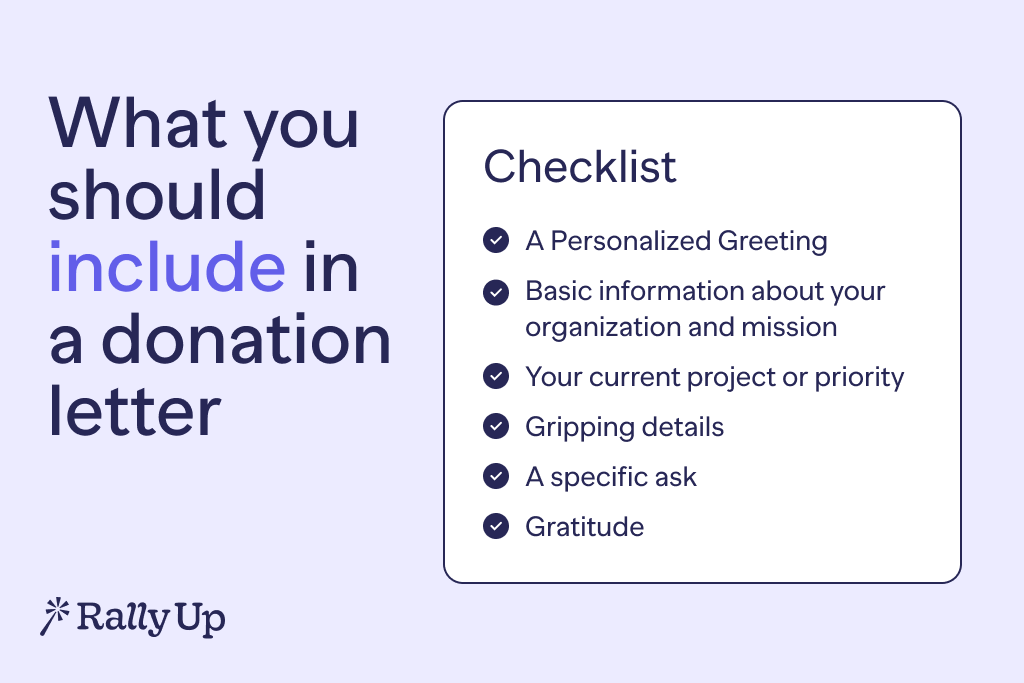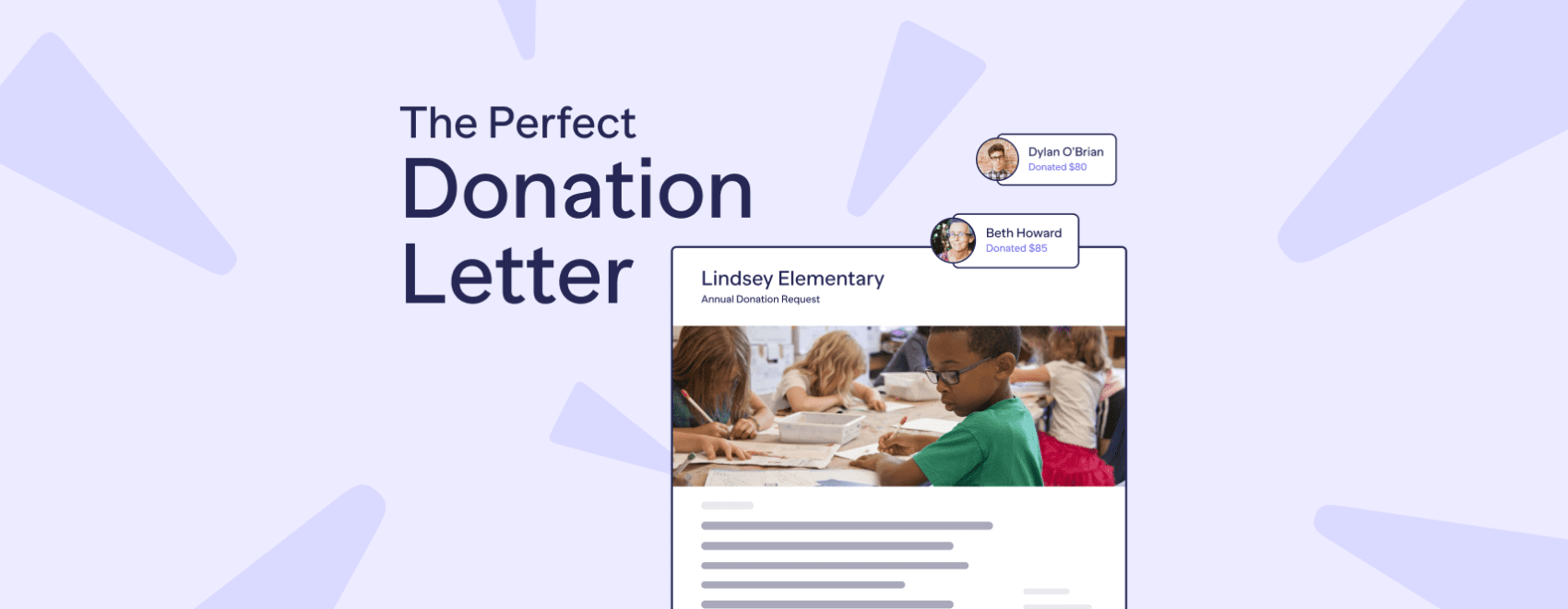When your organization relies on donations to fulfill its mission, writing a donation letter that inspires donors to give is vital. If you’re new to writing donation request letters or just want to brush up on your skills and make sure you’re writing the best donation letter possible, this article is for you. In this article, we’ll explore several topics, including:
- What is a donation letter?
- What should a donation letter include?
- Who should you send donation request letters to?
- When should you send donation request letters?
We’ll also provide a perfect donation letter template and several examples of donation request letters that inspire major giving. Let’s jump in!
What is a Donation Letter?
Put simply; a donation letter is a letter you send from your organization to potential donors that is designed to solicit donations. While donation letters should be personalized to the organization and should be written in a way that authentically represents the mission, vision, and personality of your organization, some key elements should be present in every donation request letter to ensure they are as effective as possible.

What Should a Donation Letter Include?
Your donation request letter should be easy to read, be written in a clear and pleasant tone, and get your donors excited about giving. To write an effective donation letter, be sure that each of the following elements is included.
A Personalized Greeting
The start of your letter should include a friendly greeting. This greeting should be as personalized as possible. You can include the potential donor’s name and any details you may have about their relationship to the organization, such as if they are a former or current donor or volunteer. If they are new to the organization, you can simply greet than as someone who is passionate about the issue your organization is working to address.
Some examples of effective greetings include:
Greetings Kiara,
As a former volunteer with the community food bank, we know that you’re as passionate about food justice as we are.
Hello Kevin,
As an ongoing donor with the youth literacy project, we know that getting kids engaged with books is important to you.
Greetings Mandre,
As a community member in Evergreen Lakes, we know that you want our community to thrive.
Basic information about your organization and mission
While you don’t want to bore your potential donors with a timeline of all your organization’s projects and accomplishments over the years, it’s important to provide some basic background information that will ensure donors know that you are a credible organization with a track record of success. This section should be no more than a few sentences long. Still, it should include any impressive facts or statistics that show that your organization is making a difference in the community.
Some examples of basic facts about an organization and its mission include:
At the Community Food Bank, we’ve been helping families keep food on the table for over 50 years. In the last year, we’ve provided over 10,000 meals to local families that would otherwise have gone without.
The Youth Literacy Project has been a foundational piece of youth academic support in our county since it was founded in 2010. With over 10,000 books provided to classrooms serving kids in the lowest income zip codes in our region, 50,000 volunteer hours focused on youth literacy, and 25 high-quality, expert lead professional development sessions for educators, we know we’re making a difference.
The Evergreen Lakes Conservation Society we’ve been hard at work preserving the natural elements that make our community special for the past 11 years. Through our local breeding program, we’ve increased the natural turtle population by 30%, the blue salamander population by 12%, and the native bird population by 5%. We’ve also restored natural habitats, educated our community on safe waste disposal practices, and helped children in our local schools find beauty in the great outdoors.
Your current project or priority
Donation request letters are most effective when they are focused on a specific project or priority. While many donors are often willing to give to your general expense or operational fund, the donors you’ll be soliciting through a donation request letter will want to know exactly what project they are giving to and why.
Some examples of information about a current project or priority include:
While providing meals to families has always been a priority, we’ve learned from school leaders and lead social work agencies that many kids are going hungry when they’re home from school. That’s why we’ve launched the brand-new Weekend Meals Program.
New research has underscored what we’ve always known at the Youth Literacy Project: that the first three years of life are vital to a kid’s brain development and lifelong achievement. With a grant from the National Council on Youth and support from generous donors like you, we’ll be launching the Youth Literacy Project’s Baby Steps Initiative this fall.
With the success of our local breeding programs, we know that the wildlife we’ve helped bring back will need our support to thrive. That’s why we’re raising funds to create a permanent nature preserve right here in Evergreen Lakes.
Gripping details
Your donors need to know why this specific project or initiative is urgent. It can be helpful to share what inspired you to launch this new project or focus on this new initiative and how you envision your organization making a difference in the problem you present. This section should include any information that will help donors feel personally connected to your mission and project.
Some examples of gripping details include:
Right now, over 50% of students in our community rely on free and reduced lunch during the school week. This means that their family cannot provide funds to purchase a standard school lunch. Studies show that these students are likely to face food insecurity at home and that many do not have access to nutritious food when they are not at school. Because we know that brain development, physical growth, and the freedom to pursue interests beyond those necessary to meet basic needs are all dependent on having access to adequate nutrition, it’s safe to say that these kids are falling behind their peers and missing important developmental milestones simply because of the meals they miss while not at school.
By the time they reach three years old, high-income children will have heard millions of more words than their low-income peers. They’ll have access to three times as many books, will be read aloud to twice as often, and will have a broader and more complex vocabulary. These disparities set the tone for their academic achievement, and by third grade, low-income youth will score below their higher-income peers on reading and writing assessments. These third-grade scores are often predictive of later outcomes like middle and high school graduation, college attendance, even full-time employment in adulthood.
Each year, the world loses thousands of wildlife species forever. Our nation loses hundreds, and our state and community lose dozens. Once these wildlife species are gone, we cannot bring them back, and until they are gone, we cannot know the impact their loss will have on our ecological systems and food chains. Human interference in nature is almost always the cause of a species disappearance and, last year alone, it’s estimated that eight wildlife species were lost in our region due to illegal waste dumping, overdevelopment of wetlands, and overhunting.
A specific ask
Simply hearing about a problem and what your organization is doing to address it is not usually enough to inspire donors to give. Donors need to know what their money will make a difference, and a specific ask ensures that your donors know exactly what you need from them.
Some examples of specific asks include:
We know that the problem of child hunger is daunting, but we also know that we can make a difference. For just $100, you can provide weekend meals to a child in our school system for an entire year. Your $100 will supply a child with the nutrition they need to grow into their greatest self.
Leveling the playing field between low- and high-income youth is a big task, but we know that our Baby Steps program is going to make a big difference. With just a $50 recurring monthly donation, you’ll provide one child entrance into our book-per-month club, monthly home visits from a trained literacy and development specialist, and access to Parent’s Academy for the child’s primary caregivers. These tools and resources will provide the foundation of support a child will need to reach their fullest potential.
We have the power to help end extinction, but we need your support. The total land purchase cost for the Evergreen Lakes Nature Preserve is $500,000. So far, we’ve raised over $325,000 with $175,000 to go. That means we need just 350 individual community members to donate $500. With a $500 donation, you’ll gain lifetime access to the preserve as well as naming rights to one of the first 350 animals born or hatched on the preserve.
Gratitude
Your donation request letter should always end with gratitude. You can express gratitude for the support your donor has provided in the past, for general support from the community, or for the donation you are anticipating from them. Personalizing your gratitude to include their name can also be helpful.
Some specific examples of gratitude include:
We are so grateful for your past support of the Community Food Bank. Your donations have allowed us to serve families across the region during difficult times in their lives. We look forward to boosting our impact on children through the Meals at Home program and appreciate any support you can provide!
We all want to leave the world a better place than we found it. By donating to the Literacy Projects Baby Steps Program, you’ll be doing just that. Thank you so much for your ongoing support.
The time to act is now. We’re grateful to the community at large for prioritizing the natural all around us and to you specifically for sharing our interest in making sure the world’s wildest species have someone safe to live. Thank you for your continued support.
We look forward to seeing you at the preserve!
Who Should You Send Donation Request Letters to?
You can send donation request letters to several different groups, though you’ll want to be sure to tailor them to whichever group you are sending them to. Many organizations find success in sending slightly different letters to individuals and to businesses or corporations and then further segmenting and editing their letters to previous or ongoing individual donors, new donors, previous or ongoing business or corporate donors, and new business or corporate donors.
When Should You Send Donation Request Letters?
Donation request letters can be sent at any time, but they’re most effective when tied to a specific project or initiative. Donors like to see immediate results and to feel like they are a part of something bigger than themselves so, when there is a specific project that needs to be funded, donation request letters can be particularly helpful.
Now that we’ve explored the key elements of a successful donation request letter, let’s look at some examples. These examples provide a donation request template that you can use to craft a successful donation request letter for your organization.
The Community Food Bank Sample Donation Request Letter
Greetings Kiara,
As a former volunteer with the Community Food Bank, we know that you’re as passionate about food justice as we are. At the Community Food Bank, we’ve been helping families keep food on the table for over 50 years. In the last year, we’ve provided over 10,000 meals to local families that would otherwise have gone without.
While providing meals to families has always been a priority, we’ve learned from school leaders and lead social work agencies that many kids are going hungry when they’re home from school. That’s why we’ve launched the brand-new Weekend Meals Program.
Right now, over 50% of students in our community rely on free and reduced lunch during the school week. This means that their family cannot provide funds to purchase a standard school lunch. Studies show that these students are likely to face food insecurity at home and that many do not have access to nutritious food when they are not at school. Because we know that brain development, physical growth, and the freedom to pursue interests beyond those necessary to meet basic needs are all dependent on having access to adequate nutrition, it’s safe to say that these kids are falling behind their peers and missing important developmental milestones simply because of the meals they miss while not at school.
We know that the problem of child hunger is daunting, but we also know that we can make a difference. For just $100, you can provide weekend meals to a child in our school system for an entire year. Your $100 will supply a child with the nutrition they need to grow into their greatest self.
We are so grateful for your past support of the Community Food Bank. Your donations have allowed us to serve families across the region during difficult times in their lives. We look forward to boosting our impact on children through the Meals at Home program and appreciate any support you can provide!
The Youth Literacy Project Giving Donation Letter Sample
Hello Kevin,
As an ongoing donor with the Youth Literacy Project, we know that getting kids engaged with books is important to you. The Youth Literacy Project has been a foundational piece of youth academic support in our county since it was founded in 2010. With over 10,000 books provided to classrooms serving kids in the lowest income zip codes in our region, 50,000 volunteer hours focused on youth literacy, and 25 high-quality, expert lead professional development sessions for educators, we know we’re making a difference.
New research has underscored what we’ve always known at the Youth Literacy Project: The first three years of life are vital to kids’ brain development and lifelong achievement. With a grant from the National Council on Youth and support from generous donors like you, we’ll be launching the Youth Literacy Project’s Baby Steps Initiative this fall.
By the time they reach three years old, high-income children will have heard millions of more words than their low-income peers. They’ll have access to three times as many books, will be read aloud to twice as often, and will have a broader and more complex vocabulary. These disparities set the tone for their academic achievement, and by third grade, low-income youth will score below their higher-income peers on reading and writing assessments. These third-grade scores are often predictive of later outcomes like middle and high school graduation, college attendance, even full-time employment in adulthood.
Leveling the playing field between low- and high-income youth is a big task, but we know that our Baby Steps program is going to make a big difference. With just a $50 recurring monthly donation, you’ll provide one child entrance into our book-per-month club, monthly home visits from a trained literacy and development specialist, and access to Parent’s Academy for the child’s primary caregivers. These tools and resources will provide the foundation of support a child will need to reach their fullest potential.
We all want to leave the world a better place than we found it. By donating to the Literacy Projects Baby Steps Program, you’ll be doing just that. Thank you so much for your ongoing support.

The Evergreen Lakes Conservation Society Sample Donation Request Letter
Greetings Mandre,
As a community member in Evergreen Lakes, we know that you want our community to thrive. The Evergreen Lakes Conservation Society we’ve been hard at work preserving the natural elements that make our community special for the past 11 years. Through our local breeding program, we’ve increased the natural turtle population by 30%, the blue salamander population by 12%, and the native bird population by 5%. We’ve also restored natural habitats, educated our community on safe waste disposal practices, and helped children in our local schools find beauty in the great outdoors.
With the success of our local breeding programs, we know that the wildlife we’ve helped bring back will need our support to thrive. That’s why we’re raising funds to create a permanent nature preserve right here in Evergreen Lakes.
Each year, the world loses thousands of wildlife species forever. Our nation loses hundreds, and our state and community lose dozens. Once these wildlife species are gone, we cannot bring them back, and until they are gone, we cannot know the impact their loss will have on our ecological systems and food chains. Human interference in nature is almost always the cause of a species disappearance and, last year alone, it’s estimated that eight wildlife species were lost in our region due to illegal waste dumping, overdevelopment of wetlands, and overhunting.
We have the power to help end extinction, but we need your support. The total land purchase cost for the Evergreen Lakes Nature Preserve is $500,000. So far, we’ve raised over $325,000 with $175,000 to go. That means we need just 350 individual community members to donate $500. With a $500 donation, you’ll gain lifetime access to the preserve as well as naming rights to one of the first 350 animals born or hatched on the preserve.
The time to act is now. We’re grateful to the community at large for prioritizing the natural all around us and to you specifically for sharing our interest in making sure the world’s wildest species have someone safe to live. Thank you for your continued support.
We look forward to seeing you at the preserve!
